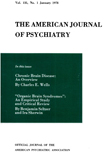A Triad of Conceptual Models for Formulating and Teaching Psychodynamics
Abstract
Many psychiatrists, psychiatric residents, and medical students experience difficulty in formulating the psychodynamics of their patients. Three conceptual models are presented as guides in formulating or teaching psychodynamics: a psychogenetic model which traces the origins, development, and lifespan of the individual; a model which involves the concept of the structures of personality; and a model of emotional interaction. Brief examples are presented to illustrate the use of each.
Access content
To read the fulltext, please use one of the options below to sign in or purchase access.- Personal login
- Institutional Login
- Sign in via OpenAthens
- Register for access
-
Please login/register if you wish to pair your device and check access availability.
Not a subscriber?
PsychiatryOnline subscription options offer access to the DSM-5 library, books, journals, CME, and patient resources. This all-in-one virtual library provides psychiatrists and mental health professionals with key resources for diagnosis, treatment, research, and professional development.
Need more help? PsychiatryOnline Customer Service may be reached by emailing [email protected] or by calling 800-368-5777 (in the U.S.) or 703-907-7322 (outside the U.S.).



